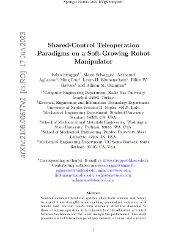| dc.contributor.author | Stroppa, F. | |
| dc.contributor.author | Selvaggio, M. | |
| dc.contributor.author | Agharese, N. | |
| dc.contributor.author | Luo, M. | |
| dc.contributor.author | Blumenschein, L.H. | |
| dc.contributor.author | Hawkes, E.W. | |
| dc.contributor.author | Okamura, A.M. | |
| dc.date.accessioned | 2023-10-19T15:05:15Z | |
| dc.date.available | 2023-10-19T15:05:15Z | |
| dc.date.issued | 2023 | |
| dc.identifier.issn | 0921-0296 | |
| dc.identifier.uri | https://doi.org/10.1007/s10846-023-01919-x | |
| dc.identifier.uri | https://hdl.handle.net/20.500.12469/4772 | |
| dc.description.abstract | Semi-autonomous telerobotic systems allow both humans and robots to exploit their strengths while enabling personalized execution of a remote task. For soft robots with kinematic structures dissimilar to those of human operators, it is unknown how the allocation of control between the human and the robot changes the performance. This work presents a set of interaction paradigms between a human and a remote soft-growing robot manipulator, with demonstrations in both real and simulated scenarios. The soft robot can grow and retract by eversion and inversion of its tubular body, a property we exploit in the interaction paradigms. We implemented and tested six different human-robot interaction paradigms, with full teleoperation at one extreme and gradually adding autonomy to various aspects of the task execution. All paradigms are demonstrated by two experts and two naive operators. Results show that humans and the soft robot manipulator can effectively split their control along different degrees of freedom while acting simultaneously to accomplish a task. In the simple pick-and-place task studied in this work, performance improves as the control is gradually given to the robot’s autonomy, especially when the robot can correct certain human errors. However, human engagement is maximized when the control over a task is at least partially shared. Finally, when the human operator is assisted by haptic guidance, which is computed based on soft robot tip position errors, we observed that the improvement in performance is dependent on the expertise of the human operator. © 2023, The Author(s), under exclusive licence to Springer Nature B.V. | en_US |
| dc.description.sponsorship | National Science Foundation, NSF: 2024247; Center for Selective C-H Functionalization, National Science Foundation; Center for Hierarchical Manufacturing, National Science Foundation, CHM, NSF; Toyota Research Institute, TRI | en_US |
| dc.description.sponsorship | This work was supported in part by Toyota Research Institute (TRI) and National Science Foundation grant 2024247. TRI provided funds to assist the authors with their research but this article solely reflects the opinions and conclusions of its authors and not TRI or any other Toyota entity. | en_US |
| dc.language.iso | eng | en_US |
| dc.publisher | Institute for Ionics | en_US |
| dc.relation.ispartof | Journal of Intelligent and Robotic Systems: Theory and Applications | en_US |
| dc.rights | info:eu-repo/semantics/openAccess | en_US |
| dc.subject | Haptics | en_US |
| dc.subject | Human-machine interaction | en_US |
| dc.subject | Shared control | en_US |
| dc.subject | Soft robotics | en_US |
| dc.subject | Teleoperation | en_US |
| dc.subject | Control theory | en_US |
| dc.subject | Degrees of freedom (mechanics) | en_US |
| dc.subject | Flexible manipulators | en_US |
| dc.subject | Human robot interaction | en_US |
| dc.subject | Industrial robots | en_US |
| dc.subject | Modular robots | en_US |
| dc.subject | Robot applications | en_US |
| dc.subject | Haptics | en_US |
| dc.subject | Human machine interaction | en_US |
| dc.subject | Human operator | en_US |
| dc.subject | Interaction paradigm | en_US |
| dc.subject | Performance | en_US |
| dc.subject | Robots manipulators | en_US |
| dc.subject | Shared control | en_US |
| dc.subject | Soft robot | en_US |
| dc.subject | Soft robotics | en_US |
| dc.subject | Telerobotic systems | en_US |
| dc.subject | Remote control | en_US |
| dc.title | Shared-Control Teleoperation Paradigms on a Soft-Growing Robot Manipulator | en_US |
| dc.type | article | en_US |
| dc.identifier.issue | 2 | en_US |
| dc.identifier.volume | 109 | en_US |
| dc.department | N/A | en_US |
| dc.identifier.doi | 10.1007/s10846-023-01919-x | en_US |
| dc.identifier.scopus | 2-s2.0-85171859599 | en_US |
| dc.institutionauthor | N/A | |
| dc.relation.publicationcategory | Makale - Uluslararası Hakemli Dergi - Kurum Öğretim Elemanı | en_US |
| dc.authorscopusid | 54891556200 | |
| dc.authorscopusid | 57188639260 | |
| dc.authorscopusid | 57207880476 | |
| dc.authorscopusid | 56336137800 | |
| dc.authorscopusid | 57190838631 | |
| dc.authorscopusid | 24780400600 | |
| dc.authorscopusid | 7103344370 | |
| dc.khas | 20231019-Scopus | en_US |
















